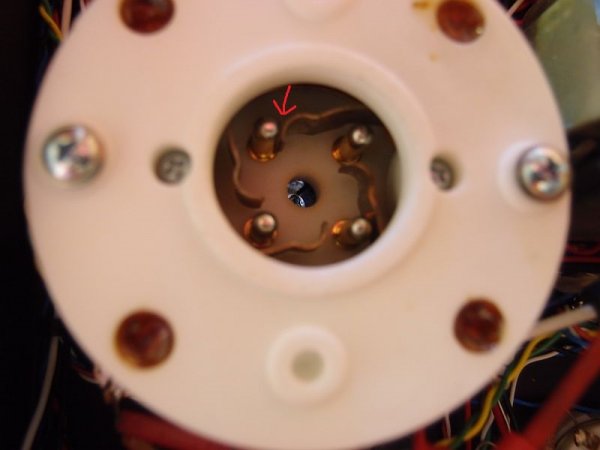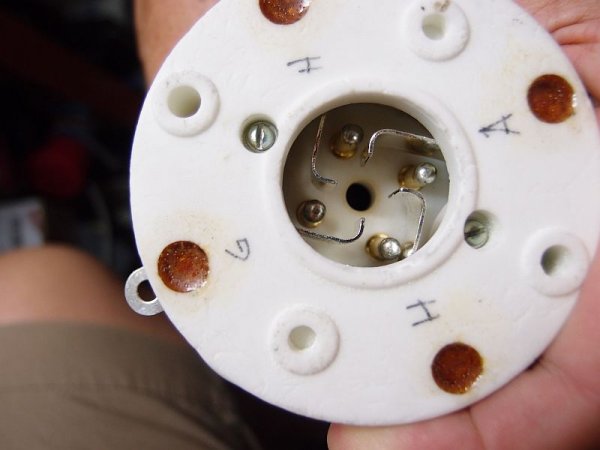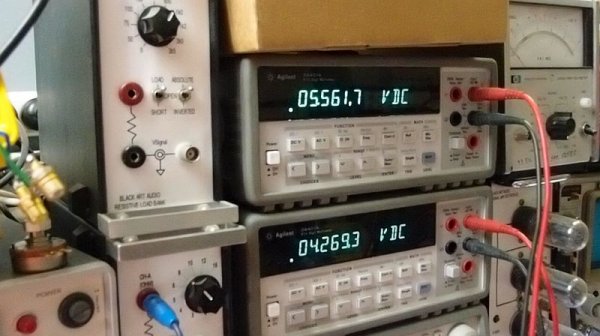I own a pair Cary CAD-211AE amplifier. This is a Class AB push/pull valve amplifier with a 6CA7 current source tube, a 6SL7 input tube, a pair of 300B driver tubes, and a pair of 845 output tubes per channel. My amp has an expensive tendency to keep blowing up the 845 mounted in the right socket of each monoblock, which is a symptom which has puzzled both me and my engineer. It has done this four times now, with three different brands of tube, and each time it is the same right socket on each monoblock.
This is my recollection of my conversation with him as he was repairing my amplifier. It was quite educational and is probably mandatory reading for anybody who owns a valve amplifier.
Why does my amplifier keep blowing the valve in the same socket? The first couple of times the valves blew, we blamed it on faulty valves. However, we smelt a rat when the same valve socket kept blowing. He got the amp on the bench and measured everything - everything looked OK. He suspected that it was physical issue with the valve socket. This is the standard valve socket as supplied by Cary:

Note how the pin for the heater can potentially contact the anode when the valve is inserted and cause a short (red arrow). He pointed out that the capacitor for the anode was massive and had "thousands of microfarads". When the 845 tube was designed, they never envisaged that anybody would attach such a large capacitor to the anode. The stored charge in the capacitor would be enough to short out the heater and kill it if there was a short circuit. He then attached his electrodes to the capacitor so that I could watch how quickly it bled current. It read 900V, and the rate at which it bled would have had us waiting for half an hour for it to discharge.
Lesson number one: do not attempt to tube roll without waiting for the capacitor to discharge.
His solution was to replace the socket with another socket which had a longer sleeve, and redesigned terminals that physically prevents the 845 tube from rocking in the socket and shorting out terminals. This one:

Q: Is there a possibility that there is a faulty component on one side of the monoblock which is causing the valve to exceed its designed specifications and causing it to fail prematurely? A:: He pointed out that this amplifier only has overall bias (i.e. a single bias potentiometer biases both push and pull sections of the amp at the same time), and not individual bias. If you have a mismatched valve, then yes - one half of the amp will pull more current than the other half pushes.
Q: But my valves are matched? Here, I have a card from Shuguang's valve tester that says they are matched! A: Those valve testers are an order of magnitude less accurate than what he can measure on the bench. In his opinion, a valve tester only tells you that a valve is OK to be used in a TV or a radio and is nowhere near accurate enough for high end audio.
Q: Well, prove it then. A: He then put my amp on the bench and measured the push and the pull channel. I could barely believe my eyes when the numbers came up:

That's right - the push part of the amp is pushing 5.56V DC, and the pull part of the amp is pulling 4.27 V DC, or a mismatch of 23% between the push and the pull!!
Q: That is shocking! Are you sure it is the valves that are responsible?!? A: He moved his electrodes to various other parts of the amp and did some maths. He said that my amp, as designed and delivered by Cary, has the + and the - to within 5% - very good manufacturing in his view. The 23% difference was entirely the fault of the valves (which were brand new out of the box and never mounted).
Q: Does the fact that these are virgin valves have anything to do with it? A: It is possible that Shuguang gave me a brand new valve and a valve which was run in. A brand new valve has to burn off the Thorium and other things (I missed what he said, but I gather it was remnants left over from manufacturing) from the anode and grid before it settles into its final value. I could even see that as the valves heated up, the numbers on the screen were changing. He would have preferred if I brought a pair of valves which had been burnt in for testing instead.
Q: Doesn't that mean that Shuguang should run in the valves first before claiming they are matched pairs and selling them? A: That's why he thinks that "matched valves" are a marketing gimmick. He has never seen a truly matched pair of valves.
Q: Does that include vintage valves? A: Vintage valves might have been manufactured to tighter tolerances depending on the factory, but the passage of time and unequal use may mean that the valves are not matched any more.
Q: If there is no such thing as a pair of truly matched valves, what does this mean for push-pull amps? A: Push-pull amps are critically dependent on matched valves, otherwise they will exhibit the kind of behaviour that mine was exhibiting on the bench.
Q: Why would anybody design a push-pull valve amp when you know full well that you are going to have problems matching valves? A: He can't read into the mind of the designer, but he pointed out that this was only one design consideration among many decisions which Dennis Had (designer of my amp) had to make. When he designed the amp, how was he to know that the market was going to be flooded by dodgy Chinese valves?
Q: But the amp is supplied with Chinese valves! A: He pointed out that the original 845's supplied by Cary were labeled "Left monoblock, left socket" and "Left monoblock, right socket". They knew what they were doing.
Q: Is there any way around this? Can a potentiometer be installed to bias each individual push-pull channel? A: Yes, Audio Research do it. Each channel can be individually biased.
Q: Then why didn't Cary do it? A: Can not read into the mind of the designer. However - when you make an amp, you can not make things too complex for the owner. At least Cary allows you to adjust the overall bias.
Q: Is this why SET's sound better? A: SET's do not have the problem of critically matching tubes between push and pull, but they have a different set of problems to a Class AB push-pull amp. (He gave me a list of them, but I do not recall all of them).
This is my recollection of my conversation with him as he was repairing my amplifier. It was quite educational and is probably mandatory reading for anybody who owns a valve amplifier.
Why does my amplifier keep blowing the valve in the same socket? The first couple of times the valves blew, we blamed it on faulty valves. However, we smelt a rat when the same valve socket kept blowing. He got the amp on the bench and measured everything - everything looked OK. He suspected that it was physical issue with the valve socket. This is the standard valve socket as supplied by Cary:

Note how the pin for the heater can potentially contact the anode when the valve is inserted and cause a short (red arrow). He pointed out that the capacitor for the anode was massive and had "thousands of microfarads". When the 845 tube was designed, they never envisaged that anybody would attach such a large capacitor to the anode. The stored charge in the capacitor would be enough to short out the heater and kill it if there was a short circuit. He then attached his electrodes to the capacitor so that I could watch how quickly it bled current. It read 900V, and the rate at which it bled would have had us waiting for half an hour for it to discharge.
Lesson number one: do not attempt to tube roll without waiting for the capacitor to discharge.
His solution was to replace the socket with another socket which had a longer sleeve, and redesigned terminals that physically prevents the 845 tube from rocking in the socket and shorting out terminals. This one:

Q: Is there a possibility that there is a faulty component on one side of the monoblock which is causing the valve to exceed its designed specifications and causing it to fail prematurely? A:: He pointed out that this amplifier only has overall bias (i.e. a single bias potentiometer biases both push and pull sections of the amp at the same time), and not individual bias. If you have a mismatched valve, then yes - one half of the amp will pull more current than the other half pushes.
Q: But my valves are matched? Here, I have a card from Shuguang's valve tester that says they are matched! A: Those valve testers are an order of magnitude less accurate than what he can measure on the bench. In his opinion, a valve tester only tells you that a valve is OK to be used in a TV or a radio and is nowhere near accurate enough for high end audio.
Q: Well, prove it then. A: He then put my amp on the bench and measured the push and the pull channel. I could barely believe my eyes when the numbers came up:

That's right - the push part of the amp is pushing 5.56V DC, and the pull part of the amp is pulling 4.27 V DC, or a mismatch of 23% between the push and the pull!!
Q: That is shocking! Are you sure it is the valves that are responsible?!? A: He moved his electrodes to various other parts of the amp and did some maths. He said that my amp, as designed and delivered by Cary, has the + and the - to within 5% - very good manufacturing in his view. The 23% difference was entirely the fault of the valves (which were brand new out of the box and never mounted).
Q: Does the fact that these are virgin valves have anything to do with it? A: It is possible that Shuguang gave me a brand new valve and a valve which was run in. A brand new valve has to burn off the Thorium and other things (I missed what he said, but I gather it was remnants left over from manufacturing) from the anode and grid before it settles into its final value. I could even see that as the valves heated up, the numbers on the screen were changing. He would have preferred if I brought a pair of valves which had been burnt in for testing instead.
Q: Doesn't that mean that Shuguang should run in the valves first before claiming they are matched pairs and selling them? A: That's why he thinks that "matched valves" are a marketing gimmick. He has never seen a truly matched pair of valves.
Q: Does that include vintage valves? A: Vintage valves might have been manufactured to tighter tolerances depending on the factory, but the passage of time and unequal use may mean that the valves are not matched any more.
Q: If there is no such thing as a pair of truly matched valves, what does this mean for push-pull amps? A: Push-pull amps are critically dependent on matched valves, otherwise they will exhibit the kind of behaviour that mine was exhibiting on the bench.
Q: Why would anybody design a push-pull valve amp when you know full well that you are going to have problems matching valves? A: He can't read into the mind of the designer, but he pointed out that this was only one design consideration among many decisions which Dennis Had (designer of my amp) had to make. When he designed the amp, how was he to know that the market was going to be flooded by dodgy Chinese valves?
Q: But the amp is supplied with Chinese valves! A: He pointed out that the original 845's supplied by Cary were labeled "Left monoblock, left socket" and "Left monoblock, right socket". They knew what they were doing.
Q: Is there any way around this? Can a potentiometer be installed to bias each individual push-pull channel? A: Yes, Audio Research do it. Each channel can be individually biased.
Q: Then why didn't Cary do it? A: Can not read into the mind of the designer. However - when you make an amp, you can not make things too complex for the owner. At least Cary allows you to adjust the overall bias.
Q: Is this why SET's sound better? A: SET's do not have the problem of critically matching tubes between push and pull, but they have a different set of problems to a Class AB push-pull amp. (He gave me a list of them, but I do not recall all of them).



















